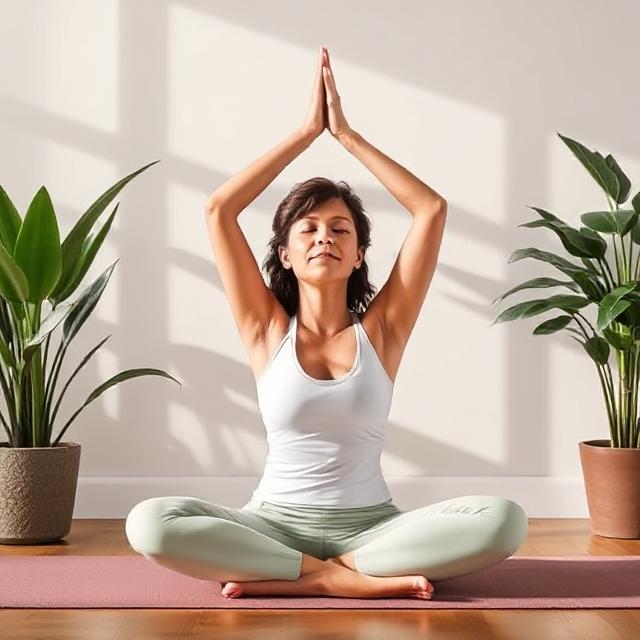The Yoga Solution for Digital Fatigue & Dry Eyes

Yoga Solution for Digital Fatigue & Dry Eyes
Are Screens Straining Your Eyes?
With rising screen-time —whether you're an IT professional, a homemaker, or a senior citizen— our eyes are taking the hit. But what if you could protect your vision with simple yoga-based solutions?
1. Screen Distance Matters!
How far should your screen be?
-
Laptops/Mobiles: Keep at arm’s length, increase font size if needed
-
Desktops: Two Arms’ length + zoom in on the text for better readability
-
TVs: 10 feet away is ideal if streaming content
📌 Tip: The farther, the better! If you can use your TV as a laptop screen, well and good.
2. Breaks Are Your Best Friend
-
Do you stare at screens non-stop?
This can lead to neck stiffness, or even serious neck issues like cervical problems. Your neck muscles are much bigger than your eye muscles, so if your neck feels strained, just imagine how much strain your eyes are going through!
📌 Tip: Take frequent breaks from work, away from screens. If it’s not possible, follow the principle DS 30-30 rule.
Every 30 minutes of sitting, take a minimum 30-second break of physical body movements.
Look 20 feet away, ideally at something green or the sky. This will help in reducing chronic fatigue.
Our ancestors had “hunter’s eyes” capable of spotting objects far away. Today, we only look an arm’s length away, damaging our vision.
3. Do You Need Eye Lubrication?
Medical eye drops? Use if prescribed or in medical need.
📌Tip: Try these natural methods:-
-
Hold water in your mouth for a few seconds, then spit it out
-
Hydrate well to reduce heat in the body
-
Apply grated cucumber to your eyes
-
Splash cold water on your eyes & face for instant freshness
4. The Blue Light Mystery — Is It Harmful?
YES! It tricks your brain into thinking it’s daytime.
📌 Tips:
-
Use blue light filters on screens
-
Reduce brightness
-
Enable dark mode all the time
-
Shift to dark mode with night vision (minus Blue Light) for better eye comfort.
Exposure to blue light, especially during evening hours, suppresses melatonin production, leading to sleep disturbances. Reducing blue light exposure in the evening can improve sleep quality.
5. How Can Yoga Help?
Your body renews itself constantly:
-
Red Blood Cells (RBCs): Replaced every 120 days
-
Intestines: Renew every 28 days
-
Eyes: Take 4 years to regenerate
📌 Tips: Start seeing changes in a week or 10 days’ time with these practices when done regularly:
Postures that improve digestion (better digestion = better eye health)
Relaxation postures: Shavasana, Yog Nidra, Brahmari
Pranayama (breathing exercises): Brahmari for relaxation
Eye breaks: Close your eyes for a few minutes to reset vision
Consistency is key!
These will help in reducing under-eye dark circles (suggestion: also check for nutritional deficiencies), eye redness, reducing stress and chronic fatigue.
Research in the International Journal of Yoga found that Yoga Nidra improves sleep patterns, reduces stress markers, and enhances overall well-being.
6ï¸. Food for Healthy Eyes
Your diet affects your eyesight. Try:
Green vegetable juice (rich in Vitamin A & C)
Broccoli, ABC Juice (Apple-Beetroot-Carrot)
📌 Tips: Eat your way to better vision!
7ï¸. Stress: The Hidden Culprit
Stress affects muscles, including eye muscles
Avoid conflicts & negativity —practice Brahmari & Shavasana to calm your mind.
📌 Tips: A relaxed mind = healthy vision!
Chronic stress elevates cortisol levels, which can lead to vision problems like eye twitching and blurred vision. Yoga and relaxation techniques help mitigate these effects.​
Article By Chandan P Mahajani
Optional
Final Takeaway:
Too much screen time? Take breaks
Strained eyes? Try yoga & natural remedies
Want better vision? Eat nutritious foods
Feeling stressed? Relax & breathe
Prioritise Quality Sleep
|
Prioritising Quality Sleep
Research Insight: A study in the Journal of Clinical & Experimental Ophthalmology highlights that poor sleep quality significantly increases the risk of eye dryness and redness due to reduced tear production. |


